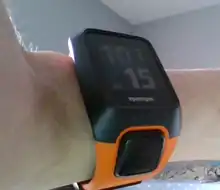
A GPS watch is a device with integrated GPS receiver that is worn as a single unit strapped onto a wrist, in the manner of a bracelet. The watch can have other features and capabilities depending on its intended purpose and be a smartwatch. GPS watches are most often used for sports and fitness purposes. Many can connect to external sensors by the wireless ANT+ protocol, and/or to a computer by USB to transfer data and configuration. Common sensors used are heart rate monitors and footpods (running cadence and speed sensor). A footpod can be used to supplement or replace GPS data, such as providing treadmill speed and distance for the watch to log and share. Recharging by USB is commonplace.
Purpose
A GPS watch is commonly a sport watch (a device used for sports and exercise in general rather than just GPS functionally). It may be designed for one particular sport or other purpose, or provide modes and features to suit several.
Examples of common purposes:
- Data logging
- Navigation
- Fitness training (Many watches can be used for many sports such as running, walking, hiking, cycling or swimming)
- Specific sport assistance (such as golf)
- Locating children and adults with intellectual disabilities that are at risk of wandering or elopement.

Features
- Display (Illuminated or passive)
- Time display
- Speed/pace display
- Map display
- Routes
- Route tracking
- Heart rate monitor compatibility
- Running cadence and speed sensor (footpod) compatibility
- Cycling cadence sensor compatibility
- Cycling power meter compatibility
- Weight scale compatibility
- Compatibility with sport transitions (such as triathlons)
- Training programs (such as intervals)
- Computer connection for logging, mapping and sharing data
- Hydration/nutrition reminders
- Reminder alarms to alternate between running and walking
- Accelerometer for tracking indoor swimming
- Touchscreen
- Larger add-on rechargeable battery for longer events (marathon, etc.)
